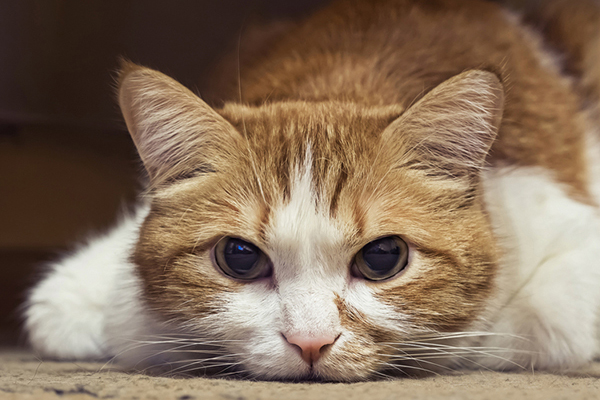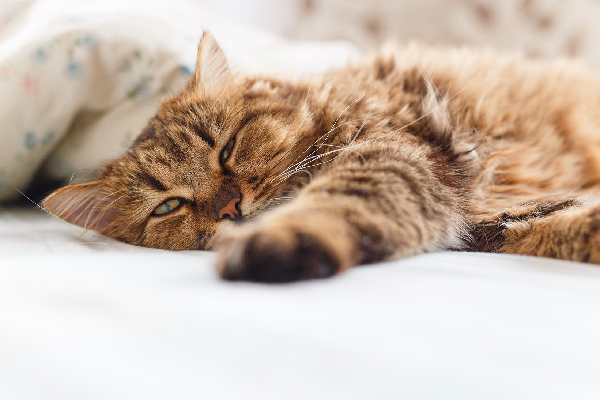Many cat parents don’t know that heart disease in cats is quite prevalent — and when one of our feline friends develops heart disease, more than 85 percent of the time it’s hypertrophic cardiomyopathy. Here’s what you need to know about hypertrophic cardiomyopathy in cats — a common and unfortunately potentially deadly chronic illness.
First, What Is Hypertrophic Cardiomyopathy in Cats?

Heart disease can affect the heart muscle, valves, pericardium or electrical conduction system, but hypertrophic cardiomyopathy in cats specifically damages the muscle, causing the walls of the heart to thicken and decreasing its efficiency and function.
Broken down, the complex medical terminology used to describe this condition also reveals what it does. “Hypertrophic” refers to something that has grown abnormally large — in this case, the left ventricle of the heart — and “cardiomyopathy” simply means “disease of the heart.”
What Are the Symptoms of Hypertrophic Cardiomyopathy in Cats?
Unfortunately, the symptoms of hypertrophic cardiomyopathy in cats can often be difficult to spot, and the disease can go unchecked for years before a diagnosis is made.
Because the symptoms of hypertrophic cardiomyopathy in cats are similar to a number of other conditions, you’ll need to see a vet to get a correct diagnosis. According to Abby Faerber, DVM, of State Line Animal Hospital in Leawood, Kan., the primary observable signs of hypertrophic cardiomyopathy in cats include panting after activity or exercise, general lethargy and lack of appetite. Some cats may also cough, which can easily be confused with more benign, everyday feline issues.
“Coughing can sometimes be mistaken for vomiting or having a hairball in cats,” Dr. Faerber says. “Cats often present to veterinarians in respiratory distress with an increased heart rate or signs of a thromboembolism. Signs of a thromboembolism include sudden paralysis of the hind limbs, painful/cold back limbs and painful vocalization.”
Dr. Faerber adds that sometimes hypertrophic cardiomyopathy in cats presents with no clinical signs. In fact, some cats with hypertrophic cardiomyopathy experience syncope (fainting) and sudden death, though this is relatively uncommon.
What Are the Causes of Hypertrophic Cardiomyopathy in Cats?
In most cases, the exact cause of hypertrophic cardiomyopathy in cats remains unknown, though genetics likely play a role. Hypertrophic cardiomyopathy in cats is more common in male cats than female cats, and the average age of onset is between five to seven years, though kittens as young as three months may be at risk.
Certain cat breeds are more susceptible to hypertrophic cardiomyopathy, including American Shorthairs and Persians.
Hypertension (high blood pressure) and hyperthyroidism can also contribute to the development of hypertrophic cardiomyopathy in cats, though these often-related conditions do not cause heart disease directly.
How Is Hypertrophic Cardiomyopathy in Cats Diagnosed?
To diagnose hypertrophic cardiomyopathy in cats, a vet may use a variety of tests to discern the extent of ventricular anomalies or damage, including echocardiography (ultrasound), electrocardiography, radiography and blood work.
These tests are primarily intended to determine whether the heart is enlarged and/or whether the heart’s walls have thickened. Other comorbidities must also be ruled out, such as hyperthyroidism and hypertension.
What Are the Treatments for Hypertrophic Cardiomyopathy in Cats?
In general, a treatment plan for hypertrophic cardiomyopathy in cats aims to control heart rate, improve congestive heart failure, decrease fluid buildup and avoid blood clots. Medications may be injected or administered orally or transdermally.
“The goal of treatment for cats with symptomatic hypertrophic cardiomyopathy is to increase the ability of the ventricles to fill with blood, relieve any congestion the cat may have, control heart arrhythmias and prevent thromboembolism,” Dr. Faerber says. “This is accomplished with different medications including diuretics, ACE inhibitors, beta blockers, and/or calcium channel blockers. Frequent monitoring of electrocardiograms, echocardiograms, radiographs and blood work may also be recommended.”
Because hypertrophic cardiomyopathy in cats is often not detected until the condition is advanced, it may be tempting to get proactive and give your middle-aged kitty therapeutic treatments before he develops hypertrophic cardiomyopathy. Unfortunately, treatments have not proven to be effective when administered before a cat starts to show symptoms. “Whether asymptomatic cats should be treated is controversial,” Dr. Faerber says. “It’s unclear if the progression of HCM can be slowed by early treatment.”
What Is the Prognosis for Hypertrophic Cardiomyopathy in Cats?
Once a cat has been diagnosed with hypertrophic cardiomyopathy, the prognosis depends on how advanced the disease is, as well as how fast it progresses and how well the cat responds to treatment.
According to Dr. Faerber, the prognosis also depends on whether hypertrophic cardiomyopathy has progressed to congestive heart failure or thromboembolism. As with any chronic health condition, regular veterinary exams are essential to manage hypertrophic cardiomyopathy in cats and prevent any complications.
“Cats with more severe changes to their heart, congestive heart failure or thromboembolism are at a greater risk for complications and sudden death,” Dr. Faerber says. “Asymptomatic cats with mild changes to their heart architecture can live for several years.”
Thumbnail: Photography © Vladdeep | iStock / Getty Images Plus.








